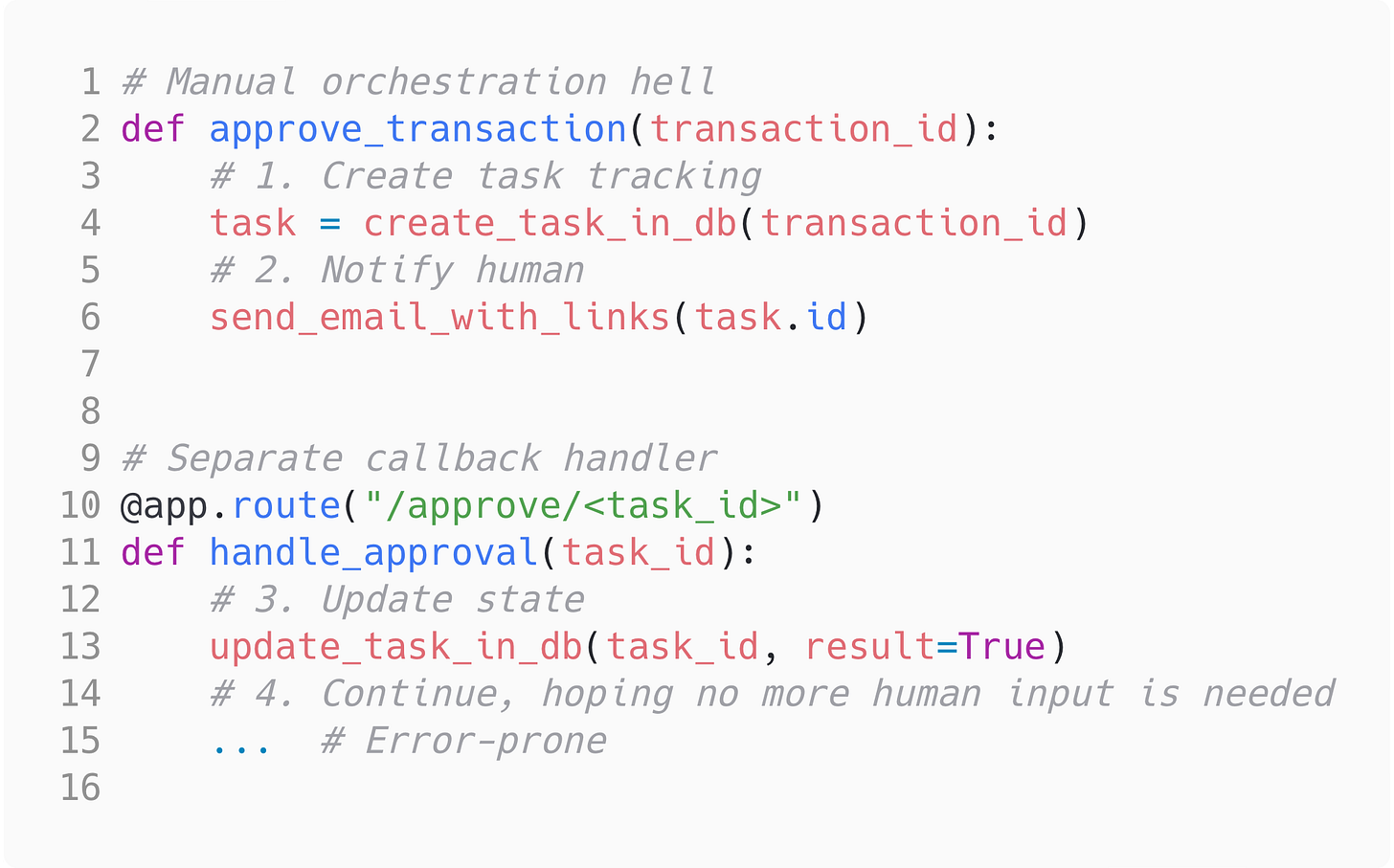Human in the Loop Made Simple: Combining Automation With Human Judgment
Distributed async/await eliminates complexity by extending the familiar async/await pattern across distributed systems.
In our technology-driven world, businesses increasingly rely on automation—but there's one critical element machines can't replace: human judgment. While Human in the Loop (HITL) systems bridge this gap, developers traditionally face complex challenges with state management and fragmented event handlers.
This post reveals how [distributed async/await] enables developers to integrate human input as easily as writing standard async code. Let’s explore this game-changing approach.
What exactly do we refer as Human in the Loop?
Systems where human judgment is incorporated into automated or computational workflows. Instead of relying solely on algorithms or machines to make decisions, these systems pause at critical junctures to solicit human input. This input can range from simple approvals (e.g., confirming an action) to complex decision-making (e.g., interpreting ambiguous data).
Examples of HITL in action include:
Content Moderation: AI systems flag potentially harmful content, but humans make the final call.
Medical Diagnostics: AI suggests potential diagnoses, but doctors validate and refine them.
Customer Support: Chatbots handle routine queries but escalate complex issues to human agents.
Creative Workflows: AI generates design drafts, but designers refine and approve the final output.
The key idea is to combine the speed and scalability of automation with the nuance, empathy, and contextual understanding that—as of now—only humans can provide.
Why is Human in the Loop Important?
Ethical Decision-Making: Machines lack moral reasoning. Human in the Loop ensures decisions with ethical implications—such as approving loans, moderating content, or diagnosing illnesses—are made with human oversight.
Handling Ambiguity: Many real-world problems involve ambiguity or incomplete data. Humans excel at interpreting context, making HITL essential for tasks like natural language processing or image recognition.
Building Trust: Users and stakeholders may trust systems more when human oversight is involved, especially in sensitive domains like healthcare or finance.
Continuous Adoption/Improvement: Organizations can incrementally adopt automated workflows while relying on employees to manage tasks that will eventually be completely handled by machines. Human feedback can also retrain and improve machine learning models, creating a virtuous cycle of learning and adaptation.
Regulatory Compliance: Many industries require human oversight for critical decisions. HITL ensures compliance with these standards.
The Hidden Cost of Traditional HITL Implementations
Most programming models treat human interaction as a second-class citizen. Building HITL workflows traditionally requires:
Queue Management: Setting up message brokers (RabbitMQ, Kafka) to track pending human tasks.
State Persistence: Manually saving/restoring workflow progress to survive process restarts.
Callback Spaghetti: Writing HTTP endpoints or event handlers to resume workflows.
Error Recovery: Reinventing timeouts, retries, and failure handling for every use case.
A simple approval workflow could balloon into 500+ lines of code across multiple systems. This infrastructure tax distracts developers from business logic and creates maintenance nightmares.
Human Interactions as First-Class Citizens
Distributed async/await eliminates this complexity by extending the familiar async/await pattern across distributed systems. Developers write human-in-the-loop logic as straightforward async functions—no queues, callbacks, or state management required.
Side-by-Side Comparison
Traditional Approach (Pseudocode)
Distributed Async/Await Approach
Key Advantages:
90% Less Code: Replace infrastructure plumbing with business logic.
Zero Callback Hell: Linear code flow instead of fragmented handlers.
Automatic Persistence: Workflows survive server restarts/cloud scaling.
Native Error Handling: Use try/except blocks around human interactions.
Why I believe you’ll love this
10x Faster Iteration: Prototype workflows in hours instead of weeks.
Serverless-Friendly: Systems may sleep while waiting for human input, then auto-resume.
Consistent Patterns: Reuse the same approach for email approvals, fraud reviews, clinical decision-making, and more.
Fraud Detection Workflow
This 20-line workflow replaces what previously required:
3 separate cloud services (DB, queue, API gateway)
5 database tables for state tracking
100+ lines of orchestration code
Real-World Applications Made Simple
Healthcare Diagnostics
Content Moderation
Conclusion: Human Judgment Meets Developer Joy
The future of automation isn’t about replacing humans—it’s about creating seamless partnerships between human intuition and machine efficiency. Distributed async/await transforms this vision from an engineering burden into a developer superpower.
By enabling teams to write human interactions as naturally as API calls, we eliminate the false choice between “automate everything” and “build unmaintainable orchestration.” A medical review workflow now shares the same mental model as fetching a database record. A fraud analyst’s approval flows as smoothly as a payment gateway response.
This isn’t just better code—it’s better business. Organizations can now:
Deploy ethical safeguards without sacrificing velocity
Scale human oversight as easily as cloud infrastructure
Iterate on workflows in hours, not weeks








Does this work for typescript-sdk?